SPN
-
Official Full Name
Sialophorin -
Overview
Sialophorin (leukosialin) is a major sialoglycoprotein on the surface of human T lymphocytes, monocytes, granulocytes, and some B lymphocytes, which appears to be important for immune function and may be part of a physiologic ligand-receptor complex involved in T-cell activation. -
Synonyms
Leukosialin;GALGP;OTTHUMP00000123397;GPL115;OTTHUMP00000196610;sialophorin (leukosialin, CD43);sialophorin (gpL115, leukosialin, CD43);CD43 antigen;Leukocyte sialoglycoprotein;Galactoglycoprotein;LSN;CD43;SPN;sialophorin
Recombinant Proteins
- Mouse
- Cynomolgus
- Human
- Rat
- Mus musculus
- HEK293
- C-His
- E.coli
- Human
- Human Cells
- Mammalian Cells
- Fc
- His
- Non
- Flag
- Avi
- GST
- DDK
- Myc
- SUMO
Background
What is SPN Protein?
SPN protein usually refers to either "surfactant protein N" or "sialophorin," based on the situation. Surfactant protein N helps lungs function by reducing surface tension, keeping airways open. Sialophorin, or CD43, is found on immune cells, aiding in cell signaling and movement. These proteins are essential for keeping our respiratory and immune systems in check.What is the Function of SPN Protein?
SPN protein can have a couple of roles depending on what it's referring to. If we're talking about surfactant protein N, it mainly helps the lungs function properly by making sure the airways stay open and reducing tension on the lung surfaces. If we're dealing with sialophorin, or CD43, it’s mostly about assisting immune cells in how they communicate and move around, playing a part in signaling when there’s an immune response. So, SPN proteins are pretty vital for keeping things running smoothly in both our lungs and immune system.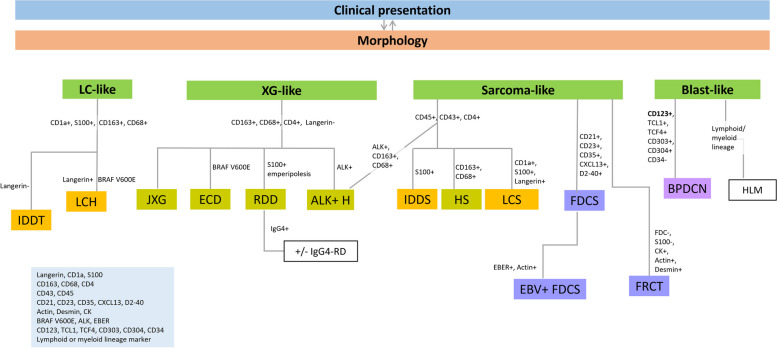
Fig1. Overall diagnostic process flow for the classification of histiocytic and dendritic cell neoplasms incorporates clinical presentations, morphology, immunohistochemistry, and molecular markers. (Sun Och Yoon, 2024)
SPN Related Signaling Pathway
The SPN-related signaling pathway can refer to different processes depending on the SPN protein in question. If it’s about surfactant protein N, it involves pathways that keep the lungs working smoothly, ensuring that breathing is easy and efficient by managing surface tension and helping in lung repair. On the other hand, if we’re talking about the signaling related to sialophorin or CD43, it’s all about the immune system. This pathway helps immune cells communicate, allowing them to move and respond to infections or inflammations effectively. So, whether it's about breathing or fighting off germs, these pathways are vital.SPN Related Diseases
When it comes to SPN-related diseases, the specific issues depend on which SPN protein we're talking about. If we're dealing with surfactant protein N, problems might pop up in the lungs. For instance, if this protein isn't working right, it could lead to breathing difficulties or lung diseases because the lungs can't stay open or repair themselves properly. On the flip side, if we're discussing sialophorin or CD43 issues, it often ties to immune system malfunctions. These could manifest as autoimmune diseases or problems with how well the body can fend off infections. So, troubles with any of these SPN proteins can lead to serious health challenges, affecting breathing or immune responses.Bioapplications of SPN
SPN proteins have cool uses depending on which one you're talking about. Surfactant protein N helps the lungs, so it's being looked at for treating breathing issues like asthma or lung damage. For sialophorin or CD43, it's all about the immune system. Researchers are working on using it to tweak immune responses, which could help with autoimmune diseases or boost the body's infection-fighting skills. Overall, SPN proteins show a lot of promise in helping with lung and immune health.Case Study
Case Study 1: Vega-Mendoza D. et al. J Cell Physiol. 2021
CD43's abnormal presence in tumors like lung, cervix, colon, and breast is linked to poor outcomes. It helps tumor cells grow and spread, and shields them from immune attacks. To understand CD43's impact on cancer, we reduced its expression in A549 lung cancer cells. These adjusted cells secreted fewer molecules tied to matrix organization, blood vessel growth, and inflammation compared to normal CD43 levels, highlighting its role in enhancing cancerous behaviors.-
 Fig1. The expression of CD43 in A549 lung tumor cells transfected with the pSuper vector (pSuper) or the CD43 RNAi pSuper vector was evaluated.
Fig1. The expression of CD43 in A549 lung tumor cells transfected with the pSuper vector (pSuper) or the CD43 RNAi pSuper vector was evaluated. -
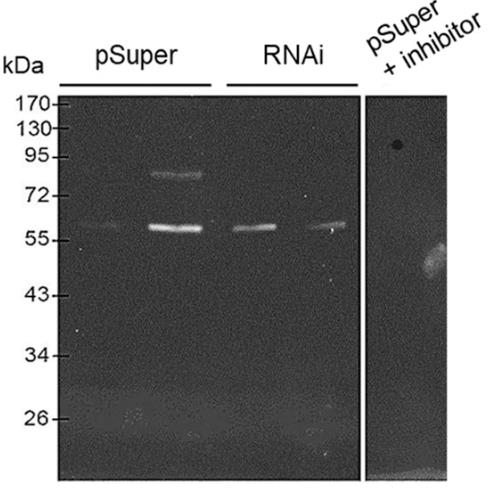 Fig2. CD43 expression level correlates with the gelatinase activity of MMP-2 and MMP-9.
Fig2. CD43 expression level correlates with the gelatinase activity of MMP-2 and MMP-9.
Case Study 2: Miki Y. et al. Cell Struct Funct. 2013
Macrophages clear out damaged cells using CD43 caps. High calcium messes with cells, so researchers boosted it to see macrophage response. Calcium ionophore A23187 and ionomycin trigger CD43 capping on Jurkat cells, leading to macrophage removal. These cells weren't dying but still got cleared. Blocking CD43 or certain sugars stopped binding, showing the role of these components and nucleolin in recognition.-
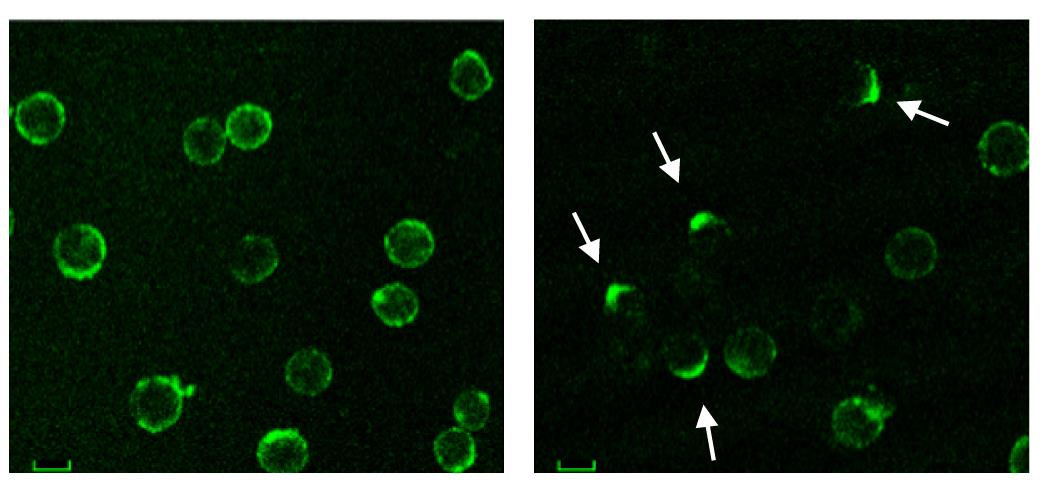 Fig3. Distribution of CD43 on Jurkat cells was observed using confocal laser scanning immunofluorescence microscopy.
Fig3. Distribution of CD43 on Jurkat cells was observed using confocal laser scanning immunofluorescence microscopy. -
 Fig4. Effect of caspase inhibitor Z-VAD-fmk on CD43 capping of A23187- or etoposide-treated Jurkat cells.
Fig4. Effect of caspase inhibitor Z-VAD-fmk on CD43 capping of A23187- or etoposide-treated Jurkat cells.
Quality Guarantee
High Purity
-
.jpg) Fig1. SDS-PAGE (SPN-1439C)
Fig1. SDS-PAGE (SPN-1439C) -
.jpg) Fig2. SDS-PAGE (SPN-1075HFL)
Fig2. SDS-PAGE (SPN-1075HFL)
Involved Pathway
SPN involved in several pathways and played different roles in them. We selected most pathways SPN participated on our site, such as Cell adhesion molecules (CAMs),Epstein-Barr virus infection, which may be useful for your reference. Also, other proteins which involved in the same pathway with SPN were listed below. Creative BioMart supplied nearly all the proteins listed, you can search them on our site.
| Pathway Name | Pathway Related Protein |
|---|---|
| Cell adhesion molecules (CAMs) | SDC2,CLDN11,JAM3B,CNTN1,OCLNA,CLDN16,ICOSLG,CLDNK,SELE,CLDN14 |
| Epstein-Barr virus infection | SPI1,PSMD12,HLA-C,PSMD2,CDK1,SFPI1,ICAM1,HDAC2,IRAK1,POLR2J |
-
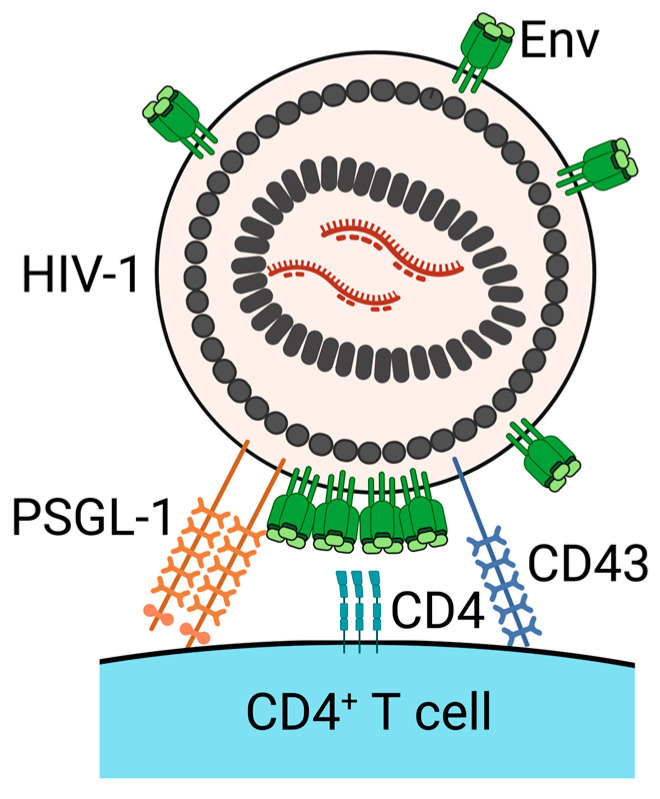 Fig1. PSGL-1 and CD43 on the surface virions inhibit HIV-1 attachment to target cells. (Tomoyuki Murakami, 2021)
Fig1. PSGL-1 and CD43 on the surface virions inhibit HIV-1 attachment to target cells. (Tomoyuki Murakami, 2021) -
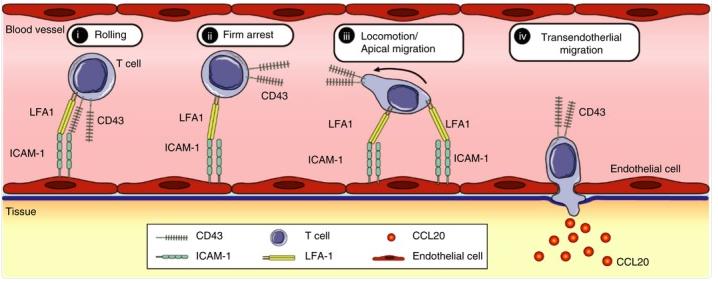 Fig2. Schematic representation of the role of CD43 in modulating Th17 cell interactions with endothelial intercellular adhesion molecule 1 (ICAM‐1) in the absence of selectins in the vasculature. (Francisco E Velázquez, 2019)
Fig2. Schematic representation of the role of CD43 in modulating Th17 cell interactions with endothelial intercellular adhesion molecule 1 (ICAM‐1) in the absence of selectins in the vasculature. (Francisco E Velázquez, 2019)
Protein Function
SPN has several biochemical functions, for example, protein binding,transmembrane signaling receptor activity. Some of the functions are cooperated with other proteins, some of the functions could acted by SPN itself. We selected most functions SPN had, and list some proteins which have the same functions with SPN. You can find most of the proteins on our site.
| Function | Related Protein |
|---|---|
| transmembrane signaling receptor activity | OR4F29,CD79B,OR4D2,GHRHRA,IL1R1,OR115-6,IL4R.1,CLEC2H,KLRC2, Cd79b |
| protein binding | BRD9,PLEKHN1,PIKFYVE,CYC1,DDRGK1,AKAP9,PPP1R13L,GHITM,TUBG1,TMEM11 |
Interacting Protein
SPN has direct interactions with proteins and molecules. Those interactions were detected by several methods such as yeast two hybrid, co-IP, pull-down and so on. We selected proteins and molecules interacted with SPN here. Most of them are supplied by our site. Hope this information will be useful for your research of SPN.
DICER1
Resources
Research Area
Granulocyte MarkersBasophils
Eosinophils
Neutrophils
T Cell Migration
CD Antigen (Granulocyte Markers)
Macrophage Markers
Monocyte Markers
Thymus-Dependent B Cell Activation
Dendritic Cell Adhesion and Migration
MDSC Phenotyping - Positive Markers
Related Services
Related Products
References
- Liu, ZQ; Liu, Y; et al. Meet-in-the-middle fault analysis on word-oriented substitution-permutation network block ciphers. SECURITY AND COMMUNICATION NETWORKS 8:672-681(2015).
- Yim, BS; Kim, JM; et al. Electrical and mechanical properties of multiwalled carbon nanotubes-reinforced solderable polymer nanocomposites. JOURNAL OF MATERIALS SCIENCE-MATERIALS IN ELECTRONICS 26:1678-1689(2015).


